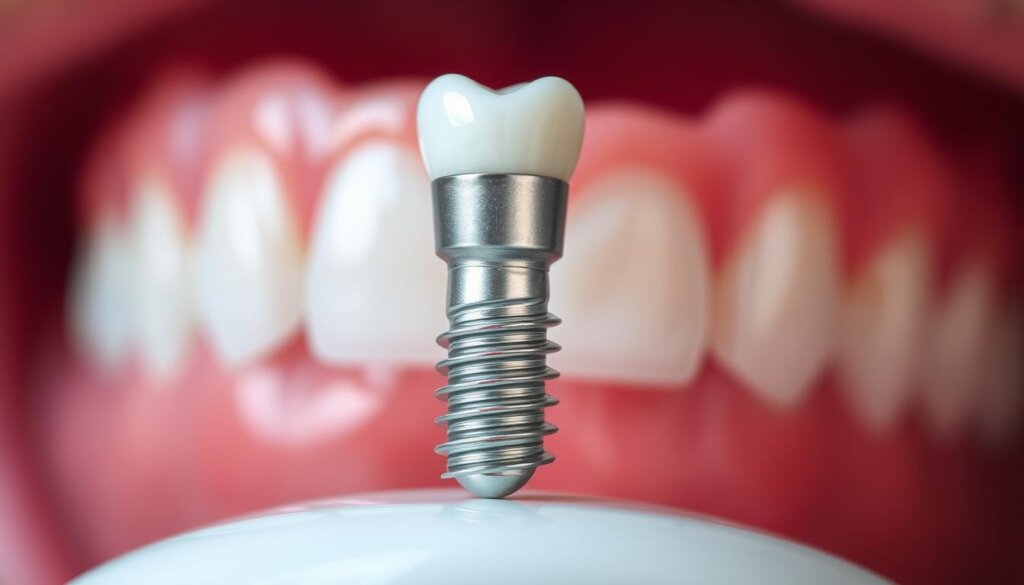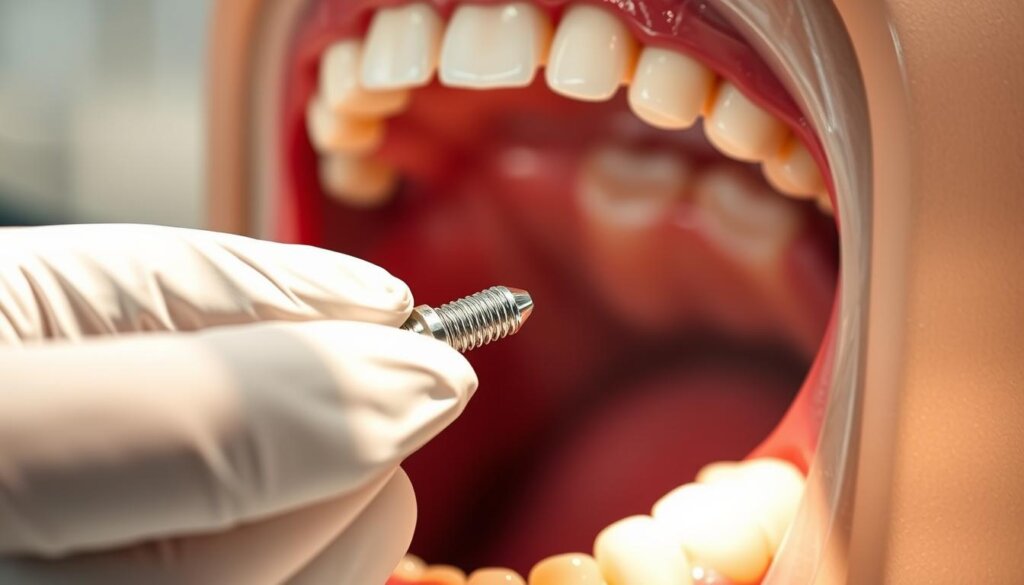Dental Implant Guide: Replacing Teeth Explained
Every year, over 5 million dental implants find their place in the US. This big number shows how important they are in today’s dentist offices. What exactly is a dental implant? How does it fill the gap of a missing tooth? Let’s dive into this guide and discover how dental implants are changing tooth replacement.
Having lost a tooth, people often feel lost on how to get their smile back. It’s more than just looks; it’s about being able to eat and talk right. Dental implants blend in with your body naturally and bring back your smile’s strength and confidence. This guide will help you and doctors understand this advanced way to replace teeth better.
Key Takeaways
- Understanding how dental implants function as a foundation for artificial teeth.
- Insights into the technical composition and surgical placement of a dental implant.
- Recognizing the in-depth procedure and the profound benefits over other tooth replacement options.
- Preparing for an informed dental implant consultation with a comprehensive guide.
- Comprehending the long-term implications on oral health and well-being.
What is a Dental Implant?
The journey in tooth replacement has made great strides, leading us to the dental implant procedure. This method is not just about filling empty spaces. It also helps to keep the bone and shape of the face, giving a lasting fix for lost teeth.
Definition of Dental Implants
Dental implants serve as a full replacement for absent tooth roots. They are made from titanium or zirconium oxide. These materials are chosen for their strength and how well they work with our bodies. The main aim with these dental implant materials is to bond with the jawbone in a process called osseointegration. This provides a strong base for crowns, bridges, or dentures.
Components of a Dental Implant
- Implant Post: Resembling a screw, this part is inserted directly into the jawbone, serving as the new root to support the structure above.
- Abutment: This component sits atop the implant post, extending through the gum line. It is crucial for securing and supporting the attached artificial tooth.
- Prosthetic Tooth: Often a crown or a bridge, this is the visible part of the dental implant, meticulously crafted to match the natural teeth in color and shape.
| Component | Material Used | Function |
|---|---|---|
| Implant Post | Titanium or Zirconium Oxide | Acts as a root, integrating with the jawbone |
| Abutment | Stainless Steel or Titanium | Connects the implant post to the prosthetic tooth |
| Prosthetic Tooth | Porcelain or Ceramic | Provides aesthetics and functional tooth surface |
Getting to know these parts helps us see why dental implants are viewed as top tooth replacement options. They offer benefits for both the look and function of one’s smile.
The Need for Dental Implants
Dental implants are often seen as the best choice for replacing missing teeth. This view comes from understanding the many reasons teeth can get lost. Reasons range from accidents to diseases like periodontitis. Losing teeth affects your health and how you feel about your smile. Dental implants help people regain their natural smile’s look and function.
Reasons for Tooth Loss
- Periodontal Disease: The leading cause of tooth loss, which damages the surrounding gums and bone essential for tooth support.
- Decay and Infection: Untreated cavities can lead to severe infection, necessitating tooth extraction.
- Accidental Injuries: Impacts from falls, sports, and accidents can result in immediate tooth loss.
Benefits of Dental Implants
- Jawbone Preservation: Implants prevent bone degeneration by stimulating bone growth, similar to natural tooth roots.
- Enhanced Comfort: Unlike removable dentures, implants are securely anchored, offering greater comfort and stability.
- Improved Oral Health: Implants do not require altering adjacent teeth, thus preserving more of the individual’s natural tooth structure.
- Aesthetic Improvement: They are designed to look and feel like natural teeth, enhancing facial aesthetics by maintaining the natural shape of the face.
When thinking about how to fix missing teeth, dental implants stand out. They’re key for people wanting to get back their lifestyle and confidence. Implants keep the jawbone healthy and look just like real teeth. This makes them a strong and attractive option.
Types of Dental Implants
In the world of implant dentistry, knowing the right types of dental implants is key. We have two main kinds: endosteal and subperiosteal implants. Each kind meets different needs, depending on the patient’s health and jaw structure.
Endosteal Implants: These are the most used dental implants. They require a two-step process. First, a titanium implant is put into the jawbone. It acts like a new root. After the bone heals around the implant, a piece called an abutment is attached. Then, an artificial tooth is connected to the abutment, making the tooth look and work like a real one.
Subperiosteal Implants: These implants sit on the jawbone but under the gum. They’re for patients without enough healthy jawbone. If a patient can’t, or doesn’t want to, have a bone-building surgery, this type is chosen. A metal frame is placed under the gum, with posts that go through the gum to hold fake teeth.
Picking the right dental implant depends on many things. These include how much bone the patient has, their overall health, and what the dentist thinks is best. Dental implants have gotten better over time. They offer good options for different patient needs.
The Dental Implant Procedure
Getting dental implants involves many important steps. Each one ensures the implant works well and lasts long. This includes initial meetings, preparing, and the actual placement of the implant.
Initial Consultation
At the first meeting, a dental expert checks if a patient can have dental implant surgery. They look closely at the patient’s health history. They also examine the mouth to see if the bones and gums are healthy enough for the implant.
Preparing for Surgery
Getting ready for the surgery means doing a lot of tests, like X-rays and CT scans. These tests help the surgeon figure out the best spot and angle for the implant in the jaw.
Implant Placement
The key part of getting a dental implant is placing it. This is done carefully under local anesthesia. It’s a skilled surgery to place the implant right and avoid problems. It’s all about making sure the implant and bone bond well.
After getting the implant, there’s a healing time. During this, the implant bonds with the jawbone, a process called osseointegration. Only after healing can the extra parts, like the abutment and crown, be added. These pieces replace the missing tooth and make it look and work like a real one.
The steps in getting a dental implant show it’s a precise and careful surgery. Every stage is key for the best results for the patient.
Healing and Recovery Process
The journey to making dental implants a part of your body involves careful monitoring. Getting a successful dental implant relies on following recovery rules closely. In this text, we’ll cover the important steps and tips to manage any discomfort.
How long it takes to recover from dental implant surgery can change from person to person. It mostly depends on your health and the specifics of the operation. The healing, which includes the bone bonding with the implant, can take several months. This process is key for creating a strong base for the new teeth.
- Initial Recovery: The first week is key for reducing swelling and avoiding infection. Expect some swelling, light bruising, and a little bleeding.
- Intermediate Healing: The next three to six months are for watching the implant closely. In this time, the bone and implant slowly join together.
- Long-term Care: Even after healing, ongoing check-ups are a must. They help make sure the implant lasts a long time.
Handling discomfort after the surgery is a critical part of recovery. Medications for pain relief are usually given, and eating soft foods is recommended. These steps help make recovery smoother and increase the chances of the implant working well.
Following the doctor’s recovery advice strictly and keeping your mouth clean plays a big part in how long the implant lasts. Doing so helps ensure the success of the implant and its long-term function.
Maintenance of Dental Implants
The success of dental implants depends a lot on proper care. By taking good care of their dental implants, patients can make sure they last a long time. Good maintenance keeps the implants and the tissues around them healthy.
Good daily hygiene is key to taking care of dental implants. Use dental tools that don’t hurt the implant or gums. For instance, interdental brushes help clean around the implants without damaging them.
- Brush twice a day with a soft-bristled brush
- Use toothpaste that’s low in abrasives
- Floss carefully to avoid moving the implants
- Use an antimicrobial mouthwash to keep bacteria away
Along with home care, visiting the dentist regularly is crucial for maintaining dental implants. These check-ups let dentists keep an eye on the implant and nearby teeth and gums. They can clean around the implants professionally to prevent problems.
| Check-Up Interval | Focus Area | Benefits |
|---|---|---|
| 3-6 Months | Implant site and surrounding gums | Early detection of potential issues |
| Annual | Overall oral health assessment | Comprehensive care and maintenance planning |
By sticking to these care tips, people can make their dental implants last longer and work better. Remember, taking care of your implants helps keep your whole mouth healthy.
Comparing Dental Implants to Other Tooth Replacement Options
When looking at tooth replacement options comparison, especially dental implant vs. bridge, knowing the differences and benefits is key. Dental implants are popular for their lasting benefits and natural function.
In comparing dental implant vs. bridge, dental implants stand out because they don’t need changing the nearby teeth. This is unlike bridges, which need nearby teeth to be changed. Implants also help keep the nearby teeth healthy and untouched.
Bridges vs. Implants
| Aspect | Bridges | Implants |
|---|---|---|
| Impact on Adjacent Teeth | Requires alteration | Does not affect |
| Longevity | 5-15 years | Can last a lifetime |
| Preservation of Jawbone | None | Helps prevent bone loss |
| Aesthetic outcome | Depends on craftsmanship | Mimics natural teeth |
Removable dentures present a different choice. They cost less but can be less stable. Implants, on the other hand, are fixed and last longer.
Dentures vs. Implants
- Dentures are cheaper but might need more adjustments and replacements over time.
- Implants cost more at first but are a lasting solution that acts like real teeth.
- Unlike dentures, implants don’t slip or make talking difficult.
It’s vital to understand the tooth replacement options comparison well. This helps in choosing the right option based on dental health and what works best for your life.
Potential Risks and Complications
Dental implants are known for their strength and success rate. However, it’s important to know about possible risks and complications. Knowing these risks helps both patients and doctors. It makes sure we’re ready and can avoid bad results.
- Infection at the Implant Site: Happens when bacteria gather at the implant’s bottom, which might cause more health issues.
- Nerve Damage: Leads to numbness or pain. This affects how comfortable and functional you feel in everyday activities.
- Sinus Problems: This is a concern with implants in the upper jaw that might extend into the sinus areas.
Some things that might cause an implant to fail include certain health conditions like diabetes or heart disease. Lifestyle choices, such as smoking, and not taking good care of your teeth also play a part. These issues can slow down healing and how well the implant joins with the bone.
| Complication | Description | Preventive Measures |
|---|---|---|
| Infection | Bacterial build-up at the implant site | Maintain rigorous oral hygiene and follow post-operative care instructions |
| Nerve Damage | Numbness or sensitivity in surrounding tissues | Thorough pre-operative planning and imaging to avoid nerve pathways |
| Sinus Complications | Disruption of sinus cavity near the implant site | Ensure accurate implant placement and consider alternative implant types |
Dealing with these challenges starts with a good talk and careful surgery planning. Doing this greatly reduces the risks of dental implant surgeries. It helps ensure that everything goes smoothly.
Costs Associated with Dental Implants
For anyone thinking about getting dental implants, knowing the costs is key. Prices can change a lot based on the materials used, the technology, and if extra steps are needed.
| Component | Typical Cost Range | Notes |
|---|---|---|
| Initial Consultation | $100 – $300 | May be covered by insurance |
| Each Implant | $1,000 – $3,000 | Excludes crown or bridge |
| Abutment and Crown | $500 – $3,000 | Cost may increase based on material choice |
| Bone Grafting (if needed) | $200 – $3,000 | Necessary if jaw bone is insufficient |
Even though insurance might not cover all of it, many plans help with some of the costs. Like the first talk or the crown. Also, new medical breakthroughs are making the process more efficient. This could lower costs over time.
There are ways to make implants more affordable. Things like payment plans or checking out different dentists can help. Dentists usually go over these money topics in great detail. They aim to make everything clear for the patient.
Dental Implant Lifespan
Dental implants are known for their strong build and the fact they can last a long time with the right care. Looking into the longevity of dental implants means checking out key things that affect how long they last.
Dental implant lifespan combines high-tech materials with careful surgery to create options that might last forever if taken care of properly. To understand their lifespan, it’s key to look at both internal and external factors.
- Oral Hygiene: Regular brushing and flossing to prevent infections that could undermine implant stability.
- Professional Dental Care: Ongoing dental check-ups allow for timely interventions to address any concerns related to implants.
- Lifestyle Choices: Avoidance of excessive force through habits like clenching or grinding teeth, which can affect implant integrity.
- Quality and Type of Implant Material: The composition and development of the implant materials play an integral role in their longevity.
To really get how these factors work together, talking about how different situations affect the longevity of dental implants helps. Better dental tech and reducing bad factors mean you might not need new ones often, leading to lasting dental support.
Success Rate of Dental Implants
The dental implant success rate shows us how effective modern dental work is. It tells us how good and reliable this treatment can be. Doctors keep an eye on patients after surgery to understand why implants usually work well over time. It’s important to know the factors affecting implant success for the best results.
Studies show that dental implants often work very well. The way they’re designed, the materials they’re made of, and how they’re put in matter a lot. But, things like how healthy the patient is, how strong their bones are, and if they follow care instructions also matter a lot for the implant to work well for a long time.
Dentists and researchers are always trying to make dental implant success rate better. They work together to improve methods and successfully treat difficult cases.
- Surgeon’s expertise
- Quality of patient’s bone density
- Precision in implant placement
- Patient’s lifestyle and health conditions
- Maintenance and follow-up care
Each of these factors affecting implant success is key to a good result. They help improve the patient’s life by making their oral health and teeth function better.
How to Choose a Dental Implant Specialist
When picking a choosing a dental implant specialist, it’s vital to look at their qualifications and what past patients have said. The skill of the specialist greatly impacts the success of your implant and how happy you are with it.
| Credentials | Patient Reviews |
|---|---|
| Board certification in oral implantology | High satisfaction rates, positive outcomes |
| Advanced training in prosthetics and dental surgery | Detailed testimonials reflecting professionalism and care |
| Membership in professional dental associations | Comments on follow-up care and patient support |
| Years of practice specializing in dental implants | Feedback on the clarity of information provided pre-surgery |
Look into the specialist’s professional background to understand their level of skill. Having lots of experience, especially with dental implants, means they’re more likely to do a great job. Also, what patients have said in reviews can show you what to expect. These comments give a real look at how well the specialist takes care of their patients and the success of the treatments.
Preparing for a Dental Implant Consultation
Getting ready for your preparing for a dental implant procedure starts with the first meeting. It’s crucial to bring questions and all needed papers. This makes sure your treatment fits you perfectly.
Before your dental implant consultation, make a list of questions. These should cover how long it takes, any risks, care after the procedure, and the dentist’s experience.
- What are the potential risks associated with my dental implant procedure?
- Can you provide examples of similar cases you have handled?
- What are the alternatives to dental implants if deemed unsuitable for me?
It’s also key to bring your full medical and dental history. This helps the dentist make a safe and precise plan for your surgery.
| Information Type | Description | Impact on Procedure |
|---|---|---|
| Medical History | Details of past medical conditions and surgeries. | Essential for assessing readiness and any potential influences on implant success. |
| Current Medications | List of all medications and supplements currently being taken. | Important for preventing any drug interactions or complications during surgery. |
| Allergies | Information about any known allergies, particularly to metals or anesthesia. | Critical for selecting suitable implant materials and surgical aids. |
Learning about the dental implant consultation and how to get ready helps a lot. It makes your treatment work better and makes you happier with the results.
Innovations in Dental Implant Technology
The relentless advancement in dental implant technology continues to push the boundaries of what is possible in restorative dentistry. The convergence of engineering and medical science is leading us into an era where the future of dental implants is continuously being reshaped by cutting-edge innovations, enhancing both the functionality and aesthetics of implants.
Latest Advancements
Recent revolutionary developments in the field of dental implants include the utilization of 3D printing technologies to create customized implants that are tailored to the specific anatomy of each patient’s oral cavity. This has significantly increased the success rates of implants by ensuring a perfect fit and reduced surgical time. Additionally, the introduction of new biocompatible materials has improved the integration of the implant with human bone, promoting faster healing times and minimizing the risk of rejection.
Future Trends in Implant Dentistry
Looking forward, the innovations in dental implant technology are set to focus on the integration of bioactive materials capable of supporting active bone regeneration. This is anticipated to significantly reduce the healing period and improve the osseointegration process. Furthermore, the application of AI and machine learning for better predictive outcomes of dental implant surgeries is on the rise, paving the way for more precise and successful implant procedures.
| Advancement | Impact |
|---|---|
| 3D Printed Dental Implants | Customization leading to better fit and reduced surgery times |
| New Biocompatible Materials | Improved bone integration and faster healing |
| Bioactive Materials | Promotes bone regeneration, reducing recovery time |
| AI in Treatment Planning | Enhanced predictive capabilities for higher success rates |
Insurance Coverage for Dental Implants
Starting your dental implant journey means looking into how to pay for it. You’ll need to know about dental implant insurance coverage and financing dental implants. Dental insurance varies a lot between plans, making it a bit tricky to figure out.
Many dental insurance plans don’t cover implants since they see them as cosmetic, not necessary. Yet, some parts of the treatment, like the crown, might get some coverage. It’s important to carefully check your insurance or talk to an agent to see what’s covered and what’s not.
What to Know About Coverage
Getting to know your dental implant insurance requires looking closely at your policy. Sometimes, insurance might cover up to half the cost if it’s deemed necessary for health. A letter from your doctor proving you need the procedure could help with coverage.
Financing Options for Implants
If your insurance won’t cover the implants, there are other ways to pay. Many dental offices let you pay in monthly payments. You can also use third-party financing or healthcare credit cards like CareCredit. These options usually have fair interest rates and flexible payback plans.
Looking into all ways to cover dental implant insurance coverage and financing dental implants is crucial. It can significantly help in making this important treatment affordable. So, doing your homework and talking to experts is key.
Conclusion: Is a Dental Implant Right for You?
Getting a dental implant is a big step in fixing a lost tooth. You need to think carefully about different dental implant choices. This means looking closely at how implants are put in, and knowing they usually work well. Also, it’s good to understand how implants can make your mouth and overall health better. This summary looks at all the important details we talked about. It helps you make a good choice.
Evaluating Your Options
When thinking about dental implants, consider if you really need to replace a tooth. Also, think about how long implants last and how stable they are. You should weigh these benefits against any risks and how much it will cost. Science has made dental treatments better, but it’s still key to think about your own health and situation. Talking to a dentist you trust about what’s best for you is a smart move.
Final Thoughts on Dental Implants
Dental implants are a great option for many people who want to have a natural-looking smile again. Looking at how dental medicine has gotten better, especially with dental implants, makes this choice even more appealing. We invite you to think about all the facts. Then, make a confident decision. Choose the dental implant that fits your needs and dreams best.









